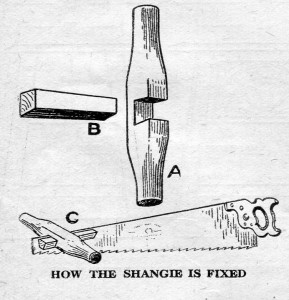We may receive a commission when you use our affiliate links. However, this does not impact our recommendations.
One of the great joys of reading old woodworking magazines is that they includes lots of tidbits that aren’t in old woodworking books – such as the one I found last night about the “Shangie.”
What’s a Shangie? It’s a shopmade device that converts a typical 26” handsaw into a two-man saw that is designed for work that requires both accuracy and exertion.
The idea is simple: There’s a cross handle that is secured to the toe of the saw with a sliding wedge, which also serves to stiffen the plate at the toe.
I dug up this article in a circa 1940 edition of The Woodworker where it was tucked in amongst the more typical fare you would expect in a magazine – plans, tool techniques and details about wood. During the last year, I’ve spent entirely way too much money amassing a library of old woodworking magazines from England dating back to 1900.
Unlike the woodworking books of the era, the magazines are quite eclectic. While the books will cover a topic (such as joinery, design, finishing or case construction) in a specific and focused way, the magazines are filled with colorful items.
The editors of The Woodworker were fascinated by the craft and village culture that was fading away around them. And even though they embraced the new machines and new materials, they always devoted ink and space to the curiosities of the craft. Such as how a staircase was made in the early 15th century, what it was like to work as a joiner’s apprentice in the 1800s, how the wheelwright, basket maker and cooper did his job.
Want to read more about the Shangie? Download the complete tidbit with the link below.
So when you see old woodworking magazines at the flea market or in GoogleBooks, take a close look – if you dare. It’s addicting to read about your craft through the eyes of the people who did it before us.
— Christopher Schwarz
One of my favorite old reprints is available in ShopWoodworking.com: “Exercises in Woodworking.” While it is not a colorful as the old magazines, it is a wealth of information on how to train your hands and eyes to become a skilled hand-tool woodworker. We reprinted it in a nice hardback format. Printed in the United States. We also produced two DVDs that get you started on the book’s lesson plan.
Here are some supplies and tools we find essential in our everyday work around the shop. We may receive a commission from sales referred by our links; however, we have carefully selected these products for their usefulness and quality.











I agree; this is a possible use of the nib. Dose the time period of the documentation coincide for the two references?
The drawing took a bit of ogling to figure out. I seemed to me that the gadget and the saw were angled in the same direction (ie. parallel) and not crossways to each other as is necessary to work as described. This is an “eye of the beholder problem” isn’t it…..
Well, Happy Thanksgiving to y’all from down here in Texas.
The length of one’s stroke would be shortened by the length of the shangie wedge, which could be a bit of a down-side.
Seriously, Heh.
Doesn’t this effectively make the saw into “pull-saw”?
I’m pretty sure that F+W corporate policy prohibits the use of the word “shangie” in any blog posts published on its web sites.
-Steve
Does it hook on to the nib? If so, I think you’ve finally settled what that thing is for.